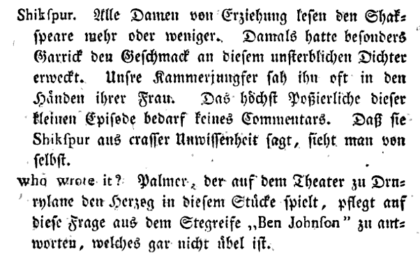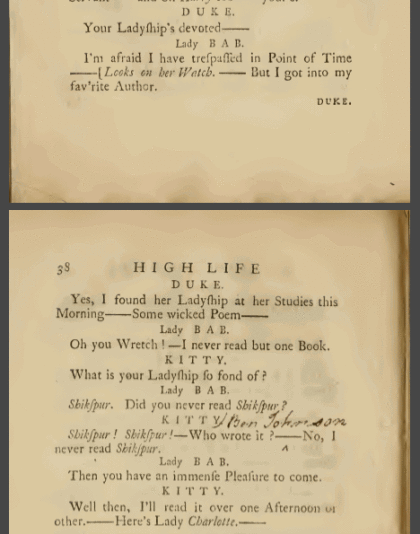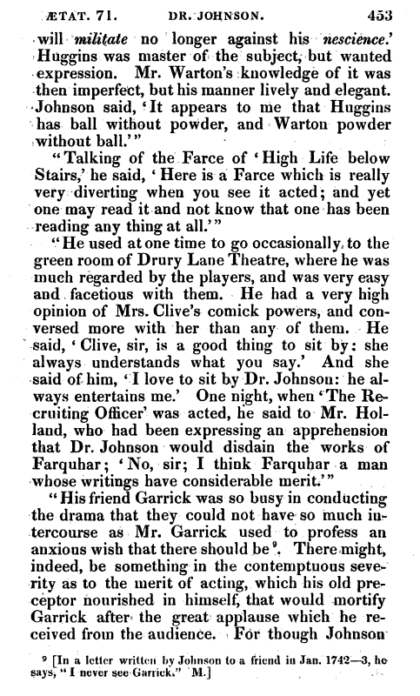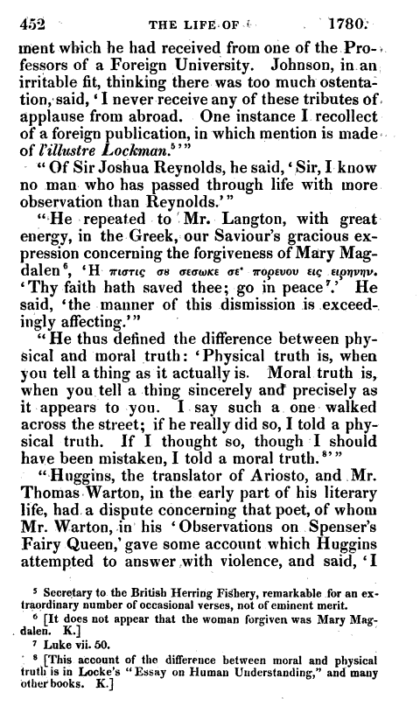A Tale of Two Truths
The “Who wrote Shikspur?” joke within the 18th century farce, “High Life Below Stairs” exists in a number of forms in different sources. All the printed editions of the play prior to 1826 (based on my best investigation) do not contain the “Ben Jonson” or “Kolly Kibber” punch lines. Additionally, Scott’s journal reports a “Sir Walter Scott” punchline used in 1827. Another account uses “Finis” as the author “I saw his name at the end of the play” instead of Kolly Kibber.
The previous entry noted there is talk in the play about topics the government didn’t want discussed. The obvious question is; was the Ben Jonson and Kolly Kibber punchlines always in the production dating back into the 18th century? Or were they a later addition? Was the Shakespeare authorship allusion an allowed topic of discussion, but not allowed on the printed page? There are four pieces of evidence suggesting the “Ben Jonson” punchline was always part of the farce.
Colly Cibber was an actor/playwright who passed away in 1757, two years before the premier of High Life Below Stairs. He was reportedly a very good, and beloved actor, and a horrendous playwright. The joke referencing him would have been topical and funny to audiences in the 1760s and 1770s. By the 19th century, the joke would need freshening, he was forgotten. Hence we see the Sir Walter Scott and Finis variations used at that time. The “Kolly Kibber” answer in the “acting copy” of the text suggests it was performed from the plays origins in 1759.
The second piece of evidence is from an edition of the play printed in Germany in 1802. This edition has the text of the play printed in English, verbatim from the 18th century printed texts that do not contain the Ben Jonson punchline. The text has notes in German. Here are the relevant notes from this 1802 edition.

click to enlarge
Here is a translation of the notes from the 1802 German edition courtesy of Elke Brackman.
“All the educated ladies more or less read Shakespeare. In those days it was especially Garrick who aroused a taste for this immortal writer. Our chambermaid often saw him (his works) in the hands of her lady/mistress. There is no need to comment on what is highly cute in this episode. The fact that she says Shikspur out of crass ignorance is evident.
Who wrote it? Palmer, who acts the part of the count in this theatre in Druryplane, is in the habit of answering this question off the cuff with “Ben Johnson”, which is not bad at all.”
The notes confirm that the “Ben Jonson” line was an off the cuff ad lib used in the later 18th century. John Palmer was known for acting the Duke’s Servant’s part. He passed away in 1798.
Another piece of evidence that the Ben Jonson line was used throughout the history of the farce occurs in a copy of the 7th edition, printed in 1763. It is a testament to High Life Below Stairs popularity that the play was already in its seventh printed edition just four years after its stage debut. The image of the page of this seventh edition shows “Ben Jonson” as an annotation in pencil. Of course we can’t prove the date of the annotation, but it’s existence in this early volume is probative.
click to enlarge
The final piece of evidence here is quite intereseting. High Life Below Stairs is mentioned by Boswell in his life of Dr. Johnson. He recounts Johnson’s comments on the play.
click to enlarge
Dr. Johnson’s comment is quite specific. When you see High Life Below Stairs acted it is “diverting,” but there is no such reaction when the play is read. Johnson is confirming for that the staged and printed versions of High Life carry differing messages. And Boswell thought this information important enough to include in his Life.
On the page before this discussion of High Life, we hear of Johnson’t musing on the two types of truth, moral and physical. Here’s the facing page from Boswell’s Life.
click to enlarge
Before we learn from Boswell that there are separate versions of one play, we learn that there are also separate types of truth, a moral truth and a physical truth. Quite an interesting juxtaposition of ideas on opposite pages.
I will propose now that the 18th century version of the Shakespeare story occurred in two forms, the moral truth that comes down to us as the Stratford legend, and a second physical truth, which the 18th century and David Garrick did not consider good for business, but was preserved in the dramas and farces of the period.
so much more to come anon.





0 comments
Kick things off by filling out the form below.
Leave a Comment